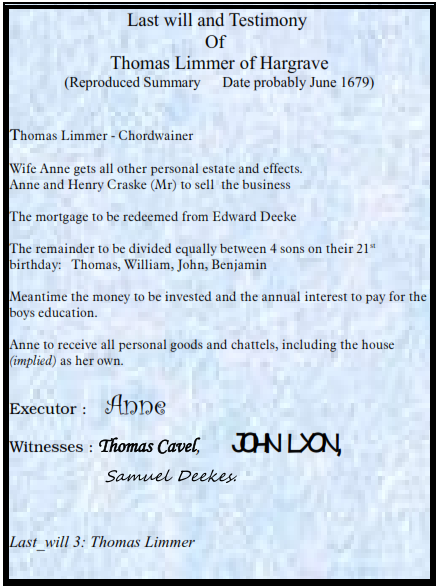Chapter 14 : What's my Line

Thomas and his wife Ann226 ran their business from the industrial /retail park situated to the south of the village227 and on the crossroads with Ousden road and Chevindon road. In the same park was a blacksmith, a wheelwright and a weaver-possibly William(1584.23). 228
Thomas does not seem to be part of the 'in crowd' 229. He probably came from outside of Hargrave. Henry Craske's family, all good military folk, were seated around Ipswich, as were most of his wife Anne's family, (although Anne Revell's parents appear to have moved to Rede).230
Thomas(1638.26) and Ann had four children231
1) Thomas baptised 15th August 1667,
2) William Baptised 22nd October 1669,
3) John Baptised 20th August 1672
4) Benjamin Baptised 15th August 1676. Benjamin died Hargrave 18 February 1699 aged twenty-three.
When Thomas(1638.26) and Ann baptised their third son, John(1672.39) in 1672, things were going well in the boot making business. Thomas secured a supply of the new good quality soft leather from Cordova in Spain and applied his trade – no longer as a boot maker – but as a Cordwainer232.

Having a very good friend named Henry Craske233 raises the question. Did Thomas, like many cobblers and Cordwainer of his day, learned his trade in the Army, or was he just educated in the Cordwainers College of London? We cannot tell. Both might be true as the army used many education establishments to work along side in training. Thomas was clearly keen his children should be well educated.
Cordwainers produced the very best boots for gentry to ride with the hounds or officers to wear when in military dress. Such was the quality of these new boots that fathers passed them on to sons in wills. Thomas saw fit to expand his business, (possibly out of a demand created by the civil war). He mortgaged his factory, (but seemingly not his house), to Mr. Deeke234 so that he might expand his business. Unfortunately, he could not see the future. Three years later, after Thomas and Anne had a fourth son, Benjamin, sadly, Thomas(1638.26) took ill and died.
All four boys were still minors when Thomas died, John(1672.39), the second youngest, being only seven years old. The house, lands and business, were sold under the watchful eye of good family friend Mr. Henry Craske235, proceeds from the sale paid off the mortgage, and the remainder invested to provide an income for Anne. A sum was set aside for the education of the four sons. Having sold the business and redeemed the mortgage in line with Thomas Limmer's will, Henry Craske settled Anne, with her children, in a smaller house in Chevington (less than a mile away from Hargrave and one stagecoach stop away). The children were probably already being educated at Chevington, which had a good school, and shop. About three years into Anne’s widowhood, she remarried. Roger Haywood236 was a widower from Chevington After they married in 1681. The couple had three children:
1) James in 1682
2) Roger in 1683
3) and Sarah in 1683).
Both Roger and Sarah died in childhood being buried in Hargrave.
Once again the chapter ends with a question Who were Thomas'(1638.26) ancestors? Here are four possible routes237.









